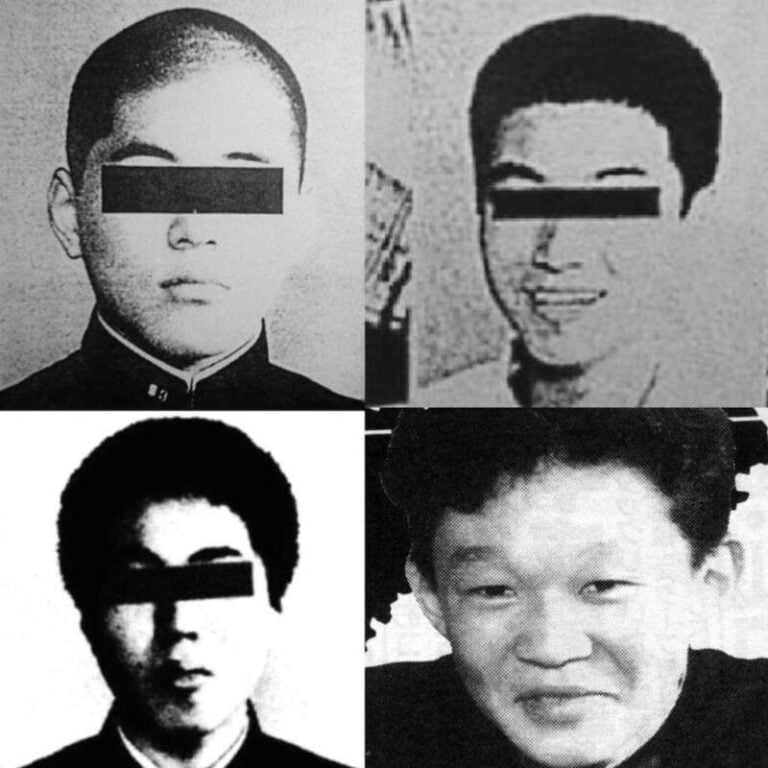Junko Furuta's Killers: Where Are They Now?
Where are the architects of unimaginable cruelty, the perpetrators of a crime that shocked a nation and continues to haunt the collective memory? The question of "Where are Junko Furuta's murderers now?" is not merely a query; it is a window into the complexities of justice, the vagaries of rehabilitation, and the enduring power of human depravity.
In the latter half of the 1980s, a shadow fell over Japan. A young high school student named Junko Furuta was abducted, held captive, and subjected to unspeakable acts of torture and sexual violence. This heinous crime, committed by a group of four teenagers, became one of the most notorious and disturbing cases in Japanese history. The details of Junko Furuta's ordeal, which spanned a harrowing 44 days, are difficult to confront, but they are essential to understanding the profound impact of this tragedy and the lingering questions surrounding those responsible.
The home was that of Shinji Minato, one of the four youths convicted in the Furuta case. It is located in a residential area, and the fact that such unimaginable cruelty could be perpetrated in the midst of everyday life adds to the chilling nature of the crime. The police found the drum containing Junko's remains, a grim discovery that brought an end to her suffering but initiated a lifelong quest for answers and justice for her family.
- Latest Telugu Movies 2025 More Reviews News Where To Watch
- Daymond Johns Wives Untold Stories Family Life Insights News
The investigation that followed revealed the horrific truth of what Junko Furuta endured. The DNA of the killers was found in the victim's body, proving that the extent of the abuse was far greater than initially understood, and that others were involved. The case exposed the dark underbelly of society and raised serious questions about the protection of vulnerable individuals and the effectiveness of the justice system. The perpetrators, teenagers themselves, were not seen as monsters at first, but as people who have committed a heinous crime that is difficult to understand.
Despite the severity of their crimes, the perpetrators received surprisingly lenient sentences. Shinji Minato, though 16 at the time of the murder, was tried as an adult. In 1990, after pleading guilty to a single charge of committing bodily injury that resulted in death, he was sentenced to 4 to 6 years in prison. However, Judge Ryuji Yanase increased the sentence to 5 to 9 years upon appeal. This initial leniency sparked outrage and highlighted the complexities of the legal system in dealing with such brutal acts. The case exposed the flaws in the system, and the sentences they were given were not enough to make amends for what they had done.
The Junko Furuta case is often referred to as "Concrete: Junko Furuta 44 Days of Hell." This chilling moniker underscores the inhumane treatment and the prolonged nature of her suffering. In 2004, a feature film, "Concrete," was based on the case, attempting to bring the horrors to a wider audience. However, the graphic nature of the crime and the details of the torture make it an incredibly difficult subject to portray, and many found the film itself to be disturbing.
- Lark Brynner The Untold Story Of Yul Brynners Daughter More
- Loveandlighttv Memes Trends The Yes King Audio Explained
The individuals responsible for the abduction, rape, torture, and murder of Junko Furuta were teenagers, each with a role in the tragedy. The ringleader, Hiroshi Miyano, was 19 years old at the time of the crime, and he was the primary instigator. The other members of the group were Nobuharu Minato (later known as Shinji Minato), Jo Ogura, and Yasushi Hiroyuki. These names are etched in infamy, representing the faces of a crime that is remembered.
After the investigation was done, the suspects were arrested. The police recognized her through her fingerprints, where Jo Ogura was captured on April 1, 1989, and other killers were discovered after certain days. The search for justice, however, did not end with their imprisonment. Many people wonder where the four doomed are, and what became of them after their release.
The current whereabouts of the individuals responsible for the abduction and murder of Junko Furuta vary. The question of "Where are Junko Furuta's murderers now?" is not just a matter of curiosity; it is a reflection on the impact of the crime, the process of justice, and the possibility of redemption. Their lives, after their release from prison, paint a picture of how society deals with such heinous crimes.
The question that arises repeatedly is: What happened to the four convicts today? The answer is complex, and the information available reveals the different paths taken by the perpetrators after their release. The individuals have not remained in the public eye. The case highlighted the issues, raising questions about the effectiveness of the system and the protection it offers to victims of violent crimes.
In 2018, Shinji Minato, allegedly assaulted a company employee, and was arrested for attempted murder. He beat a man during an altercation and cut his throat with a knife, but the guy survived. This incident is a stark reminder that the past can indeed haunt the present, as the perpetrator's actions echo the violence of the crime for which he served time. Even still, he lived a free life until 45.
Jo Ogura also changed his name after being released. The attempt to disappear into the anonymity of ordinary life is a testament to the burden of their actions. The fact that he felt compelled to alter his identity reveals the weight of the crime and the stigma attached to it. The fact that the men have been released, has caused a lot of unrest amongst people.
Hiroshi Miyano, the main perpetrator, was released from prison around 2009. Many are left wondering about the whereabouts of the individuals responsible for the murder of Junko Furuta. Miyanos case is a stark example of how the system sometimes fails to deliver the kind of justice that victims' families deserve. Miyano then asked to escort Furuta to her house, and instead, took her to an abandoned warehouse where he raped and beat her. The question of whether these individuals have been held accountable for the crimes that they have committed is an important one to ask.
The case of Junko Furuta serves as a dark testament to the capacity for human cruelty, but also provides important lessons. The fact that the perpetrators have been released, and the details of their actions in the aftermath of the crime are all important pieces of the puzzle.
Despite what the justice system hoped, these boys didn't turn out reformed. Three out of the four have been caught engaging in illegal activities since their release.
Living through the murder of ones child is the worst torment a parent can ever experience. Junko Furutas mother was the one who vandalized Junkos grave for ruining her sons life an act that underscores the complexities of the crime.
The Junko Furuta case is a sobering reminder of the dark corners that exist in society. It forces us to confront difficult questions about violence, justice, and the human condition. The individuals involved in the crime, and the impact that it had on the family of Junko Furuta, will continue to be studied for years to come.
The details of the case, as well as the questions raised by it, are still being considered. It remains a dark reminder of the importance of protecting the vulnerable, and the enduring impact of evil on those who are affected by it. The horrific murder tested Japan, and now, nearly half a century later, it continues to haunt the nation.
The Junko Furuta case highlights these issues, raising questions about the effectiveness of the system and the protection it offers to victims of violent crimes. The story is now commonly referred to as "Concrete: Junko Furuta 44 Days of Hell."
The question of "Where are the Junko Furuta murderers now?" is not just about satisfying curiosity; it is a search for understanding. The fact that the perpetrators have been released and the details of their actions after the crime are all important pieces of the puzzle.
The rape and murder of Junko Furuta is considered one of the most heinous crimes in Japanese history. The tragic tale of Junko Furuta will continue to generate questions about the nature of justice and the capacity of human behavior.
The four kidnappers kept Junko captive for over 40 days. The horrific murder that tested Japan. Unseen Japan. Inside the grisly murder of Junko Furuta, the teenage girl who was tortured for 44 days. All that's interesting. Many people wonder where the four doomed are.
The four teenagers, each playing a distinct role in her abduction, captivity, and eventual murder, consisted of the Junko Furuta murderers. In 2018, one of the convicts in the Junko Furuta case, Minato, who now goes by the name Shinji Minato, allegedly assaulted a company employee. He used a metal baton to beat him in the right shoulder. Miyano then asked to escort Furuta to her house. Miyano instead took Furuta to an abandoned warehouse where he raped and beat her.
The story of Junko Furuta is a tragedy that will continue to generate questions about the nature of justice and the capacity of human behavior. The case demands continued reflection and remembrance.
| Individual | Role in the Crime | Current Status/Known Information |
|---|---|---|
| Hiroshi Miyano | Ringleader and primary instigator | Released from prison around 2009. Current whereabouts largely unknown. |
| Nobuharu Minato (Shinji Minato) | Participated in the abduction, torture, and rape | Released from prison. In 2018, arrested for attempted murder after assaulting a company employee. |
| Jo Ogura | Participated in the abduction, torture, and rape. | Released from prison. Changed his name after release. Current whereabouts largely unknown. |
| Yasushi Hiroyuki | Participated in the abduction, torture, and rape | Released from prison. Current whereabouts largely unknown. |
Source: Information compiled from various news reports and court documents related to the Junko Furuta case.
- Chris Potoski Biography Net Worth Facts About Brandi Loves Husband
- Explore Gina Wap Hottest Videos Pics Free Now

Junko Furuta's Murder And The Sickening Story Behind It

Where Are Junko Furuta’s Killers Now?

Junko Furuta's Murder And The Sickening Story Behind It